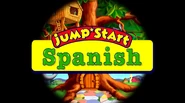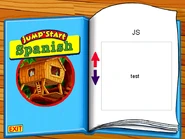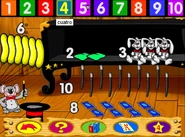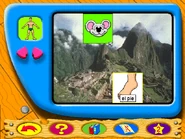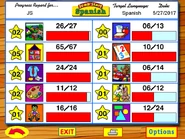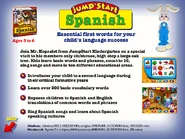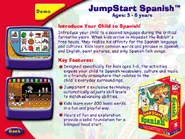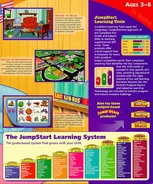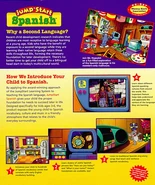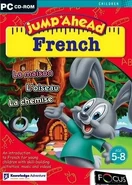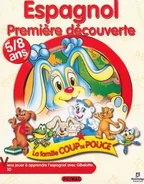JumpStart Spanish is a JumpStart game developed by Funnybone Interactive and released by Knowledge Adventure in 1997. It is intended to help kids between the ages of three and six learn Spanish.
In the game, the player joins Hopsalot in his clubhouse and plays various activities that teach Spanish.
Characters[]
- Hopsalot
- Mice
In the videos[]
- José/Michael (a robot, appears in all videos to ask questions to the other characters)
- Rosa/Jennifer (a green snake)
- Juan/Chris (a jester)
- María/Lisa (a blonde clown)
- Luis/David (a blue dragon)
Gameplay[]
Most activities in the game have two levels: Level 1 (Explore), and Level 2 (Game). On level 1, the player is allowed to freely click around and learn how to say different things in Spanish. There are no objectives in this mode, other than to gain exposure to the Spanish language. On level 2, the player is given objectives that require correctly identifying the meaning of certain Spanish words. In this mode, the player can also earn stars, which are displayed at the bottom left corner of the screen in the toolbar. Each time the player earns five stars, he or she can pick out a new fish for their aquarium.
Activities[]
- Doll's House - The player explores four different rooms in a dollhouse. On level 1, the player can freely click around to learn the names of food, furniture, and other objects. On level 2, the player plays hide and seek with some mice and must identify the hiding spots based on the words that are spoken.
- Closet - The player can learn all about the Spanish words for clothing and accessories by dressing up bears.
- Game Box - The player can learn words belonging to various categories. On level 1, the player can freely click on any image to learn words. On level 2, the player must play a matching game.
- Palette - The player can color in pictures to learn the names of different colors. On level 1, the player can freely color in the pictures however he or she would like. On level 2, the player must color in the pictures based on the colors that are spoken.
- Sketch Pad - The player can learn numbers by counting objects. On level 1, the player can freely click on any set that comes in any number and learn that number. On level 2, the player must listen to the number that is spoken, and then place the corresponding number of objects on the shelf. The objects do no matter, though. After this activity is done, he or she has to try to catch all ten items that fall into the magic hat.
- Television - The player can watch videos that show characters having conversations. There are videos about five subjects: Time, Greetings, Weather, Food, and Feelings. The player can choose whether he or she wants to hear only one language (the selected language to learn) or both English and Spanish in the videos.
- Toy Town - The player can learn the names of different buildings, vehicles, and other objects inside a miniature town. On level 1, the player can freely click around to learn the names of things. On level 2, the player must help guests get to a party by identifying where they are based on the word that is spoken.
- Wall Poster - The player can learn the names of different parts of the body with Frank, the friendly monster. On level 1, the player can click on different parts of Frank to learn the names of body parts. On level 2, the player must listen for the word that is spoken, and then click on the corresponding body part.
- Boom Box - This is where the player can freely listen to songs that help teach Spanish.
- Aquarium - Whenever the player earns five stars for completing activities, the player is automatically sent to the aquarium. Then the player can pick out something for the aquarium as a reward. The choices include fish, plants, and various decorations.
Educational Concepts[]
Spanish[]
- Vocabulary
- Numbers and Counting
- Colors
- Phrases
Trivia[]
- Frankie appears on the box art of JumpStart Spanish starting in 2003, but he never appears in the game itself.
- For the UK Edition, titled Jump Ahead French, the Progress report icon shows a horizontal line below a 20 (for a numerator) and above another 20 (for a denominator), while in the US version, it shows an "A+" instead.
- Also, while for the US edition, adults of different genders use different languages (for example, if a woman says a certain Spanish word, a man translates, and vice-versa). For the UK edition, in any subject where a woman spoke English originally, two separate women say the French and English words. Likewise, if a man did the English translation in the US version, two different men do the French and English words for that subject. However, in game mode, whenever the player selected an answer, a person of the object gender reacted to the answer in agreement or disagreement. Also, while in the US version, when Spanish is spoken, the definite articles "el/la/los/las" are used (and the same is true for English), in the UK version, when French is spoken, it is the indefinite articles "un/une/du/de la/des" that are used, but no article is used in English (even where "a" and "an" apply).

The Finnish flag in place of El Salvador's
- Most foreign releases of JumpStart Spanish retooled the game content to teach different languages other than Spanish, with French and English being common substitutes, particularly in the case of European releases of the game.
- In some countries, two versions of the game were released to teach two different languages, such being the case with Sweden (one release taught French, and the other English) and Finland (one release taught English, and the other Swedish).
- Additionally, the Finnish to English version of the game replaces the flag of El Salvador in Hopsalot's clubhouse with Finland's flag.
Gallery[]
Screenshots[]
Box art and Promotional[]
References[]
- ↑ Knowledge Adventure. New Releases. Archived on May 1, 1998. Retrieved on July 7, 2021.


